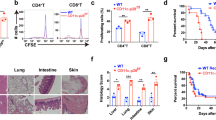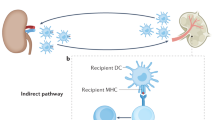Abstract
Immune responses are often regulated by opposing receptor pairs that recognize the same ligand but deliver either activating or inhibitory signals. Paired immunoglobulin-like receptors (PIRs) expressed on B cells and myeloid cells comprise a major histocompatibility complex class I recognition system that regulates the responsiveness of these cells. Here, activating PIR-A and inhibitory PIR-B bound various mouse major histocompatibility complex class I (H-2) molecules, and in vitro H-2 tetramer stimulation of PIR-B on B cells or PIR-A on macrophages induced intracellular phosphotyrosine signaling. After transfer of allogeneic splenocytes into PIR-B-deficient mice, the mice showed exacerbated graft-versus-host disease, which was due to augmented activation of recipient dendritic cells with concomitant upregulation of PIR-A and increased interferon-γ production. PIR-A-induced dendritic cell activation also led to increased proliferation of donor cytotoxic T cells. Thus, PIR-A and PIR-B are counteracting receptors that are essential for successful tissue transplantation and may regulate irrelevant reaction to autologous tissues in a constitutive way in physiological conditions.
This is a preview of subscription content, access via your institution
Access options
Subscribe to this journal
Receive 12 print issues and online access
$209.00 per year
only $17.42 per issue
Buy this article
- Purchase on Springer Link
- Instant access to full article PDF
Prices may be subject to local taxes which are calculated during checkout





Similar content being viewed by others
References
Kärre, K. NK cells, MHC class I molecules and the missing self. Scand. J. Immunol. 55, 221–228 (2002).
Cerwenka, A. & Lanier, L.L. Natural killer cells, viruses and cancer. Nat. Rev. Immunol. 1, 41–49 (2001).
Ravetch, J.V. & Lanier, L.L. Immune inhibitory receptors. Science 290, 84–89 (2000).
Shlomchik, W.D. et al. Prevention of graft versus host disease by inactivation of host antigen-presenting cells. Science 285, 412–415 (1999).
Shlomchik, W.D. et al. Prevention of graft versus host disease by inactivation of host antigen-presenting cells. Science 285, 412–415 (1999).
Heeger, P.S. T-cell allorecognition and transplant rejection: A summary and update. Am. J. Transplant. 3, 525–533 (2003).
Colonna, M., Nakajima, H., Navarro, F. & Lopez-Botet, M. A novel family of Ig-like receptors for HLA class I molecules that modulate function of lymphoid and myeloid cells. J. Leukoc. Biol. 66, 375–381 (1999).
Borges, L. & Cosman, D. LIRs/ILTs/MIRs, inhibitory and stimulatory Ig-superfamily receptors expressed in myeloid and lymphoid cells. Cytokine Growth Factor Rev. 11, 209–217 (2000).
Long, E.O. Regulation of immune responses through inhibitory receptors. Annu. Rev. Immunol. 17, 875–904 (1999).
Colonna, M. TREMs in the immune system and beyond. Nat. Rev. Immunol. 3, 445–453 (2003).
Nakajima, H., Samaridis, J., Angman, L. & Colonna, M. Human myeloid cells express an activating ILT receptor (ILT1) that associates with Fc receptor γ-chain. J. Immunol. 162, 5–8 (1999).
Colonna, M. et al. A common inhibitory receptor for major histocompatibility complex class I molecules on human lymphoid and myelomonocytic cells. J. Exp. Med. 186, 1809–1818 (1997).
Colonna, M. et al. Human myelomonocytic cells express an inhibitory receptor for classical and nonclassical MHC class I molecules. J. Immunol. 160, 3096–3100 (1998).
Chang, C.C. et al. Tolerization of dendritic cells by TS cells: the crucial role of inhibitory receptors ILT3 and ILT4. Nat. Immunol. 3, 237–243 (2002).
Manavalan, J.S. et al. High expression of ILT3 and ILT4 is a general feature of tolerogenic dendritic cells. Transpl. Immunol. 11, 245–258 (2003).
Hayami, K. et al. Molecular cloning of a novel murine cell-surface glycoprotein homologous to killer cell inhibitory receptors. J. Biol. Chem. 272, 7320–7327 (1997).
Kubagawa, H., Burrows, P.D. & Cooper, M.D. A novel pair of immunoglobulin-like receptors expressed by B cells and myeloid cells. Proc. Natl. Acad. Sci. USA 94, 5261–5266 (1997).
Yamashita, Y. et al. Genomic structures and chromosomal location of p91, a novel murine regulatory receptor family. J. Biochem. 123, 358–368 (1998).
Kubagawa, H. et al. Biochemical nature and cellular distribution of the paired immunoglobulin-like receptors, PIR-A and PIR-B. J. Exp. Med. 189, 309–318 (1999).
Kubagawa, H. et al. Paired immunoglobulin-like receptors of activating and inhibitory types. Curr. Top. Microbiol. Immunol. 244, 137–149 (1999).
Takai, T. & Ono, M. Activating and inhibitory nature of the murine paired Ig-like receptor (PIR) family. Immunol. Rev. 181, 215–222 (2001).
Maeda, A., Kurosaki, M. & Kurosaki, T. Paired immunoglobulin-like receptor (PIR)-A is involved in activating mast cells through its association with Fc receptor γ chain. J. Exp. Med. 188, 991–995 (1998).
Yamashita, Y., Ono, M. & Takai, T. Inhibitory and stimulatory functions of paired Ig-like receptor (PIR) family in RBL-2H3 cells. J. Immunol. 161, 4042–4047 (1998).
Ono, M., Yuasa, T., Ra, C. & Takai, T. Stimulatory function of paired immunoglobulin-like receptor-A in mast cell line by associating with subunits common to Fc receptors. J. Biol. Chem. 274, 30288–30296 (1999).
Bléry, M. et al. The paired Ig-like receptor PIR-B is an inhibitory receptor that recruits the protein-tyrosine phosphatase SHP-1. Proc. Natl. Acad. Sci. USA 95, 2446–2451 (1998).
Maeda, A., Kurosaki, M., Ono, M., Takai, T. & Kurosaki, T. Requirement of SH2-containing protein tyrosine phosphatases SHP-1 and SHP-2 for paired immunoglobulin-like receptor B (PIR-B)-mediated inhibitory signal. J. Exp. Med. 187, 1355–1360 (1998).
Ujike, A. et al. Impaired dendritic cell maturation and increased TH2 responses in PIR-B−/− mice. Nat. Immunol. 3, 542–548 (2002).
Ho, L.H., Uehara, T., Chen, C.C., Kubagawa, H. & Cooper, M.D. Constitutive tyrosine phosphorylation of the inhibitory paired Ig-like receptor PIR-B. Proc. Natl. Acad. Sci. USA 96, 15086–15090 (1999).
Liang, S., Baibakov, B. & Horuzsko, A. HLA-G inhibits the functions of murine dendritic cells via the PIR-B immune inhibitory receptor. Eur. J. Immunol. 32, 2418–2426 (2002).
Hogarth, P.M. Fc receptors are major mediators of antibody based inflammation in autoimmunity. Curr. Opin. Immunol. 14, 798–802 (2002).
Takai, T. Roles of Fc receptors in autoimmunity. Nat. Rev. Immunol. 8, 580–592 (2002).
Shiroishi, M. et al. Human inhibitory receptors Ig-like transcript 2 (ILT2) and ILT4 compete with CD8 for MHC class I binding and bind preferentially to HLA-G. Proc. Natl. Acad. Sci. USA 100, 8856–8861 (2003).
Hart, G., Flaishon, L., Becker-Herman, S. & Shachar, I. Ly49D receptor expressed on immature B cells regulates their IFN-γ secretion, actin polymerization, and homing. J. Immunol. 171, 4630–4638 (2003).
Takai, T., Li, M., Sylvestre, D., Clynes, R. & Ravetch, J.V. FcRγ chain deletion results in pleiotrophic effector cell defects. Cell 76, 519–529 (1994).
Pedersen, A.E., Jacoby, B.F., Skov, S. & Claesson, M.H. MHC class I is functionally associated with antigen receptors in human T and B lymphomas. Cell. Immunol. 173, 295–302 (1996).
Quelle, F.W. et al. JAK2 associates with the βc chain of the receptor for granulocyte-macrophage colony-stimulating factor, and its activation requires the membrane-proximal region. Mol. Cell. Biol. 14, 4335–4341 (1994).
Mul, A.L., Wakao, H., O'Farrell, A.M., Harada, N. & Miyajima, A. Interleukin-3, granulocyte-macrophage colony stimulating factor and interleukin-5 transduce signals through two STAT5 homologs. EMBO J. 14, 1166–1175 (1995).
Blazar, B.R. et al. Blockade of programmed death-1 engagement accelerates graft-versus-host disease lethality by an IFN-γ-dependent mechanism. J. Immunol. 171, 1272–1277 (2003).
Cosman, D. et al. A novel immunoglobulin superfamily receptor for cellular and viral MHC class I molecules. Immunity 7, 273–282 (1997).
Willcox, B.E., Thomas, L.M. & Bjorkman, P.J. Crystal structure of HLA-A2 bound to LIR-1, a host and viral major histocompatibility complex receptor. Nat. Immunol. 4, 913–919 (2003).
Kogure, T. et al. Effect of interleukin 2 on killer cell inhibitory receptors in patients with rheumatoid arthritis. Ann. Rheum. Dis. 60, 166–169 (2001).
Dulphy, N. et al. Functional modulation of expanded CD8+ synovial fluid T cells by NK cell receptor expression in HLA-B27-associated reactive arthritis. Int. Immunol. 14, 471–479 (2002).
Kollnberger, S. et al. Cell-surface expression and immune receptor recognition of HLA-B27 homodimers. Arthritis. Rheum. 46, 2972–2982 (2002).
Laferté, S., Loh, L.C. & Keeler, V. Monoclonal antibodies specific for human tumor-associated antigen 90K/Mac-2 binding protein: Tools to examine protein conformation and function. J. Cell. Biochem. 77, 540–559 (2000).
Acknowledgements
We thank H. Kubagawa and M.D. Cooper for 6C1 hybridoma. Supported by the Core Research for Evolutional Science and Technology program of the Japan Science and Technology Agency; a Grant-in-Aid from the Ministry of Education, Culture, Sports, Science and Technology of Japan; the Virtual Research Institute of Aging of Nippon Boehringer Ingelheim; and the Center of Excellence program Center for Innovative Therapeutic Development Towards the Conquest of Signal Transduction Diseases.
Author information
Authors and Affiliations
Corresponding author
Ethics declarations
Competing interests
The authors declare no competing financial interests.
Rights and permissions
About this article
Cite this article
Nakamura, A., Kobayashi, E. & Takai, T. Exacerbated graft-versus-host disease in Pirb−/− mice. Nat Immunol 5, 623–629 (2004). https://doi.org/10.1038/ni1074
Received:
Accepted:
Published:
Issue Date:
DOI: https://doi.org/10.1038/ni1074
This article is cited by
-
Paired immunoglobulin-like receptor B is an entry receptor for mammalian orthoreovirus
Nature Communications (2023)
-
Innate Immune Responses in Transplant Immunity
Current Transplantation Reports (2023)
-
VCAM1 confers innate immune tolerance on haematopoietic and leukaemic stem cells
Nature Cell Biology (2022)
-
Activity-dependent modulation of hippocampal synaptic plasticity via PirB and endocannabinoids
Molecular Psychiatry (2019)
-
PirB Overexpression Exacerbates Neuronal Apoptosis by Inhibiting TrkB and mTOR Phosphorylation After Oxygen and Glucose Deprivation Injury
Cellular and Molecular Neurobiology (2017)



